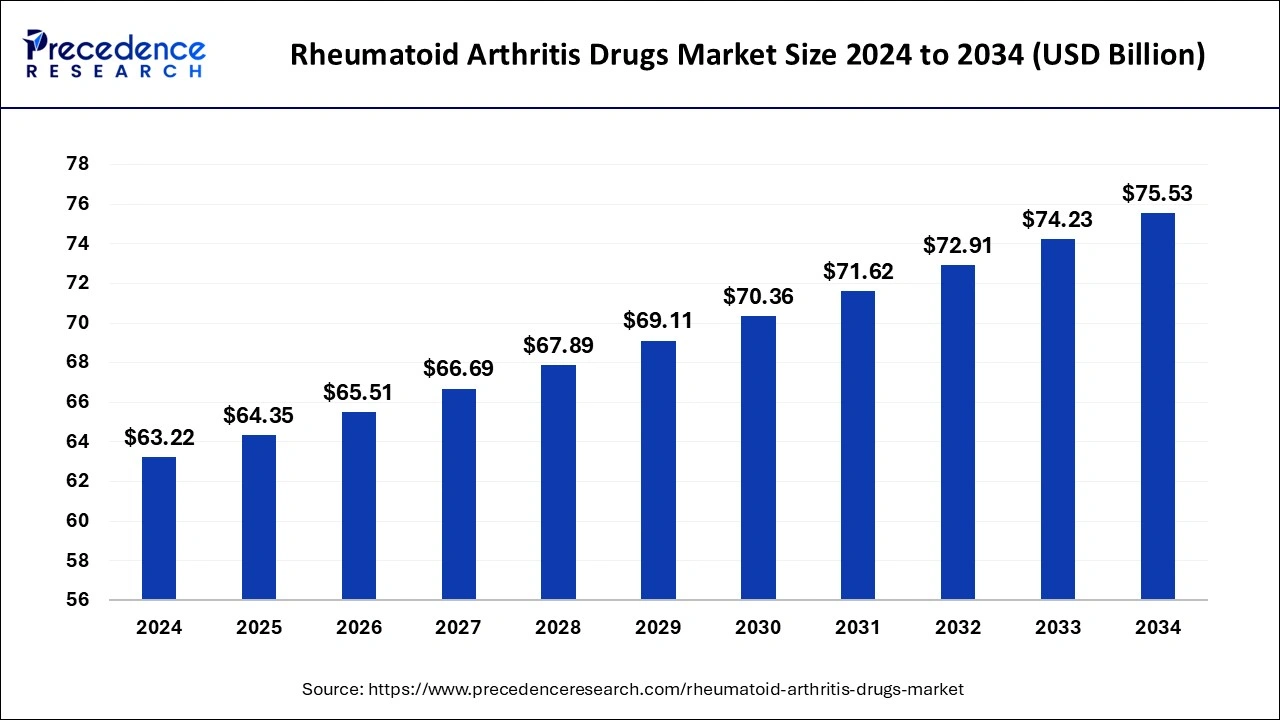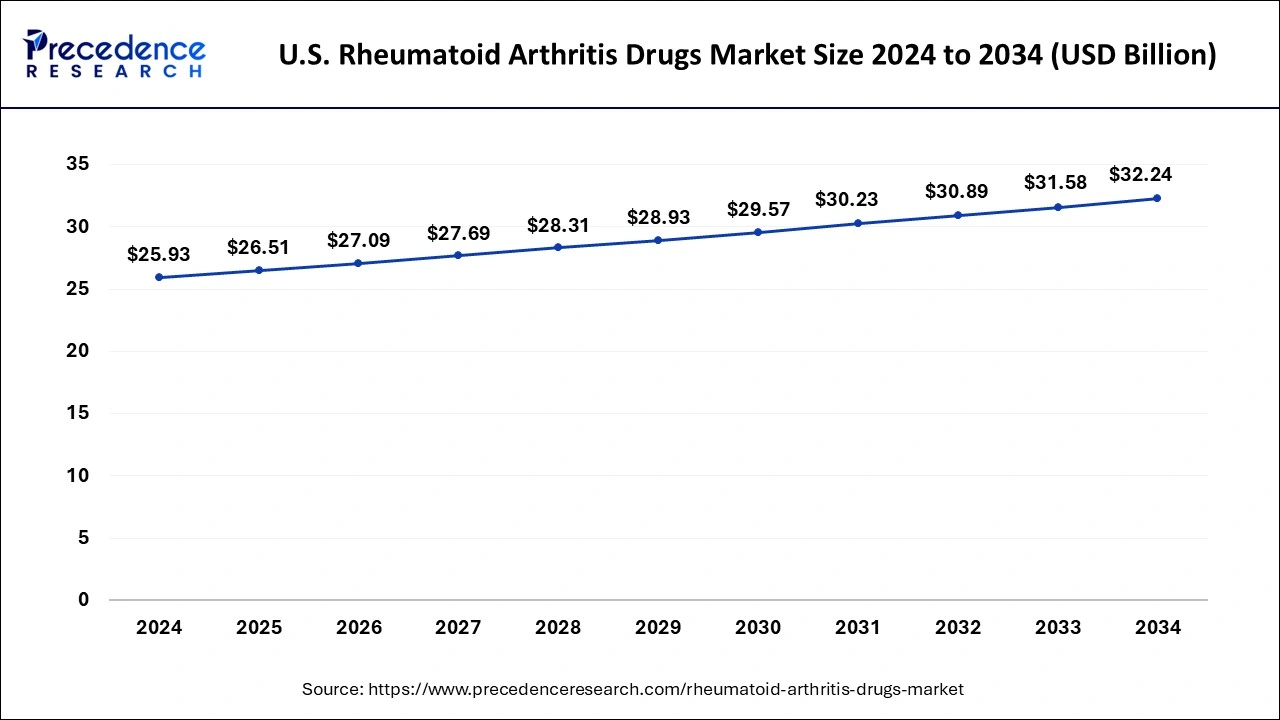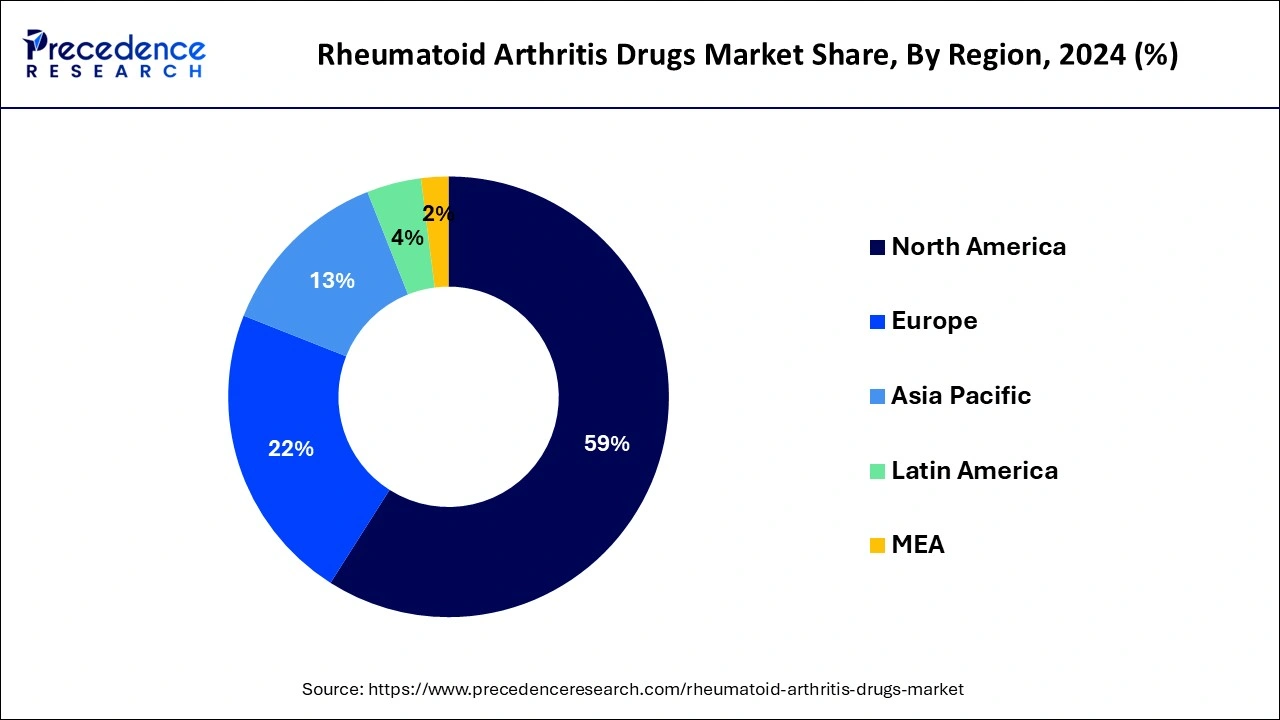July 2024
The global rheumatoid arthritis drugs market size is accounted at USD 64.35 billion in 2025 and is forecasted to hit around USD 75.53 billion by 2034, representing a CAGR of 1.80% from 2025 to 2034. The North America market size was estimated at USD 37.30 billion in 2024 and is expanding at a CAGR of 1.82% during the forecast period. The market sizing and forecasts are revenue-based (USD Million/Billion), with 2024 as the base year.
The global rheumatoid arthritis drugs market size was calculated at USD 63.22 billion in 2024 and is predicted to reach around USD 75.53 billion by 2034, expanding at a CAGR of 1.80% from 2025 to 2034.

The U.S. rheumatoid arthritis drugs market size was evaluated at USD 25.93 billion in 2024 and is projected to be worth around USD 32.24 billion by 2034, growing at a CAGR of 2.20% from 2025 to 2034.

North America region has garnered 58.25% revenue share in 2024. As per the Centers for Disease Control and Prevention, nearly one in every four individuals in the U.S. or 58.5 million people, has arthritis. Furthermore, the government of Canada estimates that 374,000 of Canadians aged 16 and up have rheumatoid arthritis. Due to this disease’s widespread prevalence, more medicines will be used, resulting in rheumatoid arthritis drugs market expansion in the North America region. In addition, easy approvals by government agencies on pharmaceuticals and drugs are also driving the growth of North America rheumatoid arthritis drugs market.
Asia-Pacific, on the other hand, is expected to develop at the fastest rate during the forecast period. The Asia-Pacific rheumatoid arthritis drugs market’s expansion is being fueled by increased awareness of disease remission therapy, high public and private healthcare expenditure, and rising rheumatoid arthritis incidences. Furthermore, revenue growth in Asia-Pacific region is expected to be aided by simple access to high quality healthcare, a robust clinical product portfolio, advantageous reimbursement rules, and the approval of innovative pharmaceuticals. The acceptance of urban lifestyle is resulting in an increase in the number of patients in the region. This, together with rising healthcare spending, is likely to drive Asia-Pacific rheumatoid arthritis drugs market forward. The favorable regulatory rules for biosimilars are expected to improve demand for medicines are driving the overall growth of the market.

One of the significant factors driving the growth of global rheumatoid arthritis drugs market is rising prevalence of rheumatoid arthritis. The worldwide prevalence of rheumatoid arthritis, based on a systematic review was predicted to be 0.46%, as per the study published in November 2020. As a result, more rheumatoid arthritis drugs will be adopted, propelling the rheumatoid arthritis drugs market forward.
The global rheumatoid arthritis drugs market is expected to benefit significantly from increased launches of innovative biologics and expanding generic medication penetration. In Japan, for example, Eli Lilly and Company’s release of Olumiant in 2017 is expected to stimulate revenue growth. Likewise, AbbVie’s Upadacitinib, a JAK1-selective inhibitor, is expected to be approved in 2019. Due to the favorable reimbursement landscape, recently authorized biologics like Kevzara and Xeljanz are expected to have a high market penetration.
Another factor driving the growth of global rheumatoid arthritis drugs market is growing patient awareness regarding rheumatoid arthritis disorders. In the U.S., 52.2 million persons affected with rheumatoid arthritis in 2013. Due to inadequate therapeutic benefits, the majority of patients diagnosed with Disease Modifying Antirheumatic Drugs remain dissatisfied. A combination of Disease Modifying Antirheumatic Drugs and biologics is more likely to provide therapeutic advantages for this patient population. Thus, there is a movement in the rheumatoid arthritis drugs market toward combination medicines that deliver better benefits for patients.
The growth of global rheumatoid arthritis drugs market is also being driven by growing constant efforts for development of rheumatoid arthritis drugs and medications by government agencies. The government is also taking assistance of major market players for development and growth of global rheumatoid arthritis drugs market. In addition, government agencies are also investing in innovative and latest technologies for the development of rheumatoid arthritis drugs in the global market. As a result, all of these aforementioned factors are boosting the growth of global rheumatoid arthritis drugs market.
| Report Coverage | Details |
| Market Size in 2025 | USD 64.35 Billion |
| Market Size by 2034 | USD 75.53 Billion |
| Growth Rate from 2025 to 2034 | CAGR of 1.80% |
| Largest Market | North America |
| Fastest Growing Market | Asia-Pacific |
| Base Year | 2024 |
| Forecast Period | 2025 to 2034 |
| Segments Covered | Molecule, Sales Channel, and Route of Administration |
| Regions Covered | North America, Europe, Asia-Pacific, Latin America, and Middle East & Africa |
The biologics segment accounted revenue share of around 61% in 2023. The biopharmaceutical production capacity is expected to increase as manufacturing capabilities are improved. In the synthesis and processing of biopharmaceuticals, single use methods are also being used. In addition, researchers are looking towards more productive species and expression methods. Revenue generation is expected to be fueled by the development of reagents and cell lines that improve biological products output.
The biosimilars segment is fastest growing segment over the forecast period. The segment’s expansion is aided by increased availability, low price, and favorable results. Their demand is considerable in emerging nations; however, because to the introduction of newer, more effective products, they are progressively gaining momentum in industrialized nations. Glenmark Pharmaceuticals released a biosimilar for Humira in India in January 2018. In upcoming years, new biosimilars are expected to cause a dramatic shift in prescription patterns.
The over-the-counter drugs (OTC) segment dominated the rheumatoid arthritis drugs market in 2023. The prescription drugs include a wide range of vaccinations and therapies for the treatment and diagnostics of rheumatoid arthritis. Many market companies are conducting clinical studies for the development of novel treatments for a variety of conditions, but the prescription drug landscape has changed dramatically as a result of the rising availability of generic medicines.
The prescription drugs segment is expected to witness strong growth from 2024 to 2033. The over-the-counter drugs are pharmaceuticals that are regarded safe to purchase without a prescription from a medical expert. These drugs are sold lawfully without a prescription in medical stores and hospital pharmacies.
The global rheumatoid arthritis drugs industry is dominated by biopharmaceutical manufacturers. Due to the price sensitive population in emerging nations, only a few market players provide both generic and branded pharmaceuticals. To strengthen their market position, companies are working on developing unique chemical units and innovative compounds. The global rheumatoid arthritis drugs market is expected to become more competitive as new biologics are developed and a robust clinical pipeline is built. Because of the low entry barriers in the rheumatoid arthritis drugs industry, new market players are expected in the generic pharmaceuticals segment.
By Molecule
By Sales Channel
By Route of Administration
By Geography
For inquiries regarding discounts, bulk purchases, or customization requests, please contact us at sales@precedenceresearch.com
No cookie-cutter, only authentic analysis – take the 1st step to become a Precedence Research client
July 2024
January 2025
March 2025
March 2025